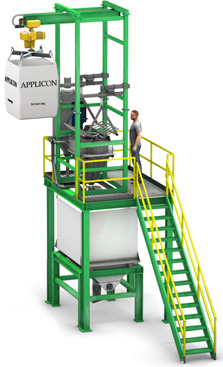Ratio metering can be used in some applications to eliminate the separate step of physically mixing dry ingredients.

Ratio Blending
The simplest ratio blending system is to simultaneously merge two product streams together, using volumetric feeders. This is inexpensive, but only works reliably for free flowing ingredients. It is useful for either low volume, or high volume throughput, where a ratio variance of 2 to 5% is acceptable. The ratio of the two streams can be 50/50 or any other that is required.
Ratio Batching
Ratio batching is a step up in accuracy, and cost. Weigh batches of A, B, C, etc., and drop them together. This is useful for moderate throughput, but is too slow for high volume applications. The constituents can be weighed sequentially on a single scale, or simultaneously on individual scales. The latter allows better accuracy for minor or micro ingredients.
Ratio metering by continuous loss-in-weight feeding, is useful for high tonnage production system, but also for low rate application such as feeding a continuous compounder/extruder.
An example application might be merging the two containers from a spray dryer run, to establish a more uniform particle distribution.
Gravimetric ratio batch blending is more accurate, but slower and more expensive. It too relies on downstream handling to accomplish the actual blending.
Gravimetric ratio metering using loss-in-weight monitoring of two or more product streams allows very high throughput is commonly used in plastics injection molding, typically followed by a small batch blender.